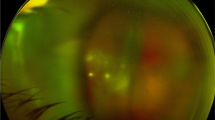Abstract
Background
We describe a case of posttraumatic endophthalmitis unresponsive to systemic (amoxicillin+clavulanic acid and piperacillin/tazobactam), intra-ocular (vancomycin) and topical (ofloxacin, tetracycline and sulfametoxazole) antibiotic therapy. Microbiological and confocal microscopy studies of a nylon corneal suture revealed the presence of a slime-producing strain of Staphylococcus epidermidis.
Methods
We describe the history and clinical presentation of a 77-year-old man in whom a high-grade posttraumatic endophthalmitis resolved only after the removal of a single nylon corneal suture. Microbiological investigations of the aqueous, vitreous and suture were performed, and the propensity of the suture-associated isolate to form biofilm was assessed using confocal microscopy.
Results
A single stain of S. epidermidis was isolated from both aqueous and vitreous specimens and from the suture. The planktonic form of the isolate was susceptible in vitro to the antibiotics administered to the patient, but the strain was capable of forming biofilms and this phenotype showed resistance to high concentrations of the same antibiotics.
Conclusions
The presence of a slime-producing strain of S. epidermidis should be considered in endophthalmitis that is unresponsive to specific antibiotic therapy, especially in cases in which an intra-ocular foreign body (e.g., a suture) is present.


Similar content being viewed by others
References
Balaban N, Giacometti A, Cirioni O et al (2003) Use of the quorum-sensing inhibitor RNAIII-inhibiting peptide to prevent biofilm formation in vivo by drug-resistant Staphylococcus epidermidis. J Infect Dis 187:625–630
Cook G, Costerton JW, Darouiche RO (2000) Direct confocal microscopy studies of the bacterial colonization in vitro of a silver-coated heart valve sewing cuff. Int J Antimicrob Agents 13:169–173
Costerton, JW, Cheng KJ, Geesey GG et al (1987) Bacterial biofilms in nature and disease. Annu Rev Microbiol 41:435–464
Costerton JW, Stewart PS, Greenberg EP (2001) Bacterial biofilm: a common cause of persistent infections. Science 284:1318–1322
Leid JG, Costerton JW, Shirtliff ME et al (2002) Immunology of staphylococcal biofilm infections in the eye: new tools to study biofilm endophthalitis. DNA Cell Biol 21:405–413
Leid JG, Shirtliff ME, Costerton JW, Stoodley P (2002) Human leukocytes adhere, penetrate, and respond to Staphylococcus aureus biofilms. Infect Immun 70:6339–6345
Kodjikian L, Burillon C, Lina G et al (2003) Biofilm formation on intraocular lenses by a clinical strain encoding the ica locus: a scanning electron microscopy study. Invest Ophthalmol Vis Sci 44:4382–4387
Selan L, Thaller MC, Berlutti F et al (1989) Effect of slime production on the antibiotic susceptibility of isolates from prosthetic infections. J Chemother 1:369–373
Selan L, Berlutti F, Passariello C et al (1993) Proteolytic enzymes: a new treatment strategy for prosthetic infections? Antimicrob Agents Chemother 37:2618–2621
Stewart PS, Costerton JW (2000) Antibiotic resistance of bacteria in biofilm. Lancet 358:135–138
Acknowledgement
Partial financial support from MIUR, Rome, Italy (FIRB RBNE01P4B5).
Author information
Authors and Affiliations
Corresponding author
Additional information
Financial support: partially by MIUR, Rome, Italy (FIRB RBNE01P4B5).
Rights and permissions
About this article
Cite this article
Nucci, C., Artini, M., Pasmore, M. et al. A microbiological and confocal microscopy study documenting a slime-producing Staphylococcus epidermidis isolated from a nylon corneal suture of a patient with antibiotic-resistant endophthalmitis. Graefe's Arch Clin Exp Ophthalmol 243, 951–954 (2005). https://doi.org/10.1007/s00417-004-1110-9
Received:
Revised:
Accepted:
Published:
Issue Date:
DOI: https://doi.org/10.1007/s00417-004-1110-9




